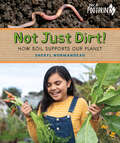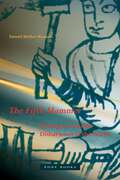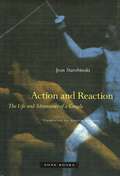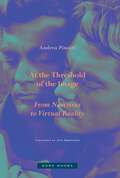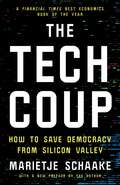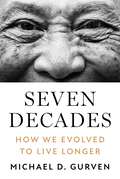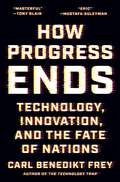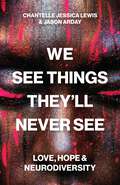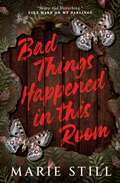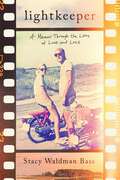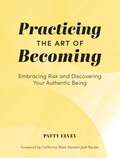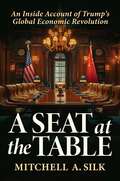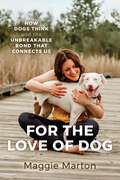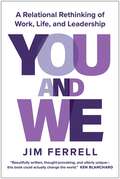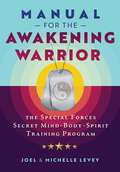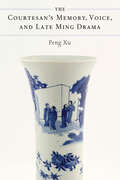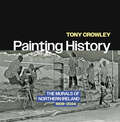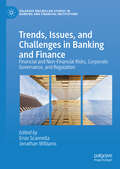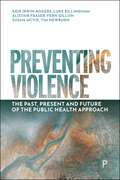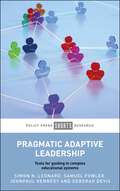- Table View
- List View
Not Just Dirt!: How Soil Supports Our Planet (Orca Footprints)
by Sheryl NormandeauDirt is essential to life on Earth. Farmers grow food crops, such as wheat, barley and corn, in soil. We mine the soil for resources that we use in manufacturing and for fuel. Soil is used in the construction of roads and buildings, and it provides food and habitat for animals that live both underground and above ground. But soil can be easily destroyed by human activity and natural disasters. Pollution, deforestation and the effects of the climate crisis are damaging soil at an alarming rate. Explore the biological and economic importance of soil to living organisms, the threats it faces and why we must preserve and conserve soil for the future. Let's dig in and get the dirt on soil. Praise for Sheryl Normandeau: "Exploring seeds more broadly than most children's books on the topic, this volume encourages readers to collect, plant, and share seeds—a small, yet powerful resource."—Booklist review for Save Our Seeds "Normandeau conversationally provides readers with amazing facts and ways to utilize what they learned, including steps everyone can take to save seeds. Readers will be left empowered to help protect seeds."—Children's Literature Comprehensive Database (CLCD) review for Save Our Seeds
The Laughter Factor: The 5 Humor Tactics to Link, Lift, and Lead
by Adam ChristingTransform your connections and leadership with five research-backed humor tactics to master authentic workplace comedy, boost team engagement, and lead with laughter.Discover the secret weapon that transforms relationships, boosts creativity, and enhances leadership: humor. The Laughter Factor reveals how laughter isn't just a source of joy—it's a powerful tool for connection and success. Whether you're a leader, teacher, salesperson, or simply someone seeking stronger relationships, this book equips you with five humor tactics to captivate, connect, and inspire.With decades of experience as a comedian and keynote speaker, author Adam Christing shares his proven methods to make humor work for anyone, anywhere. These five fundamental humor strategies include:Surprise—Use the power of the unexpected to delight and captivate.Poke—Master the art of self-deprecating humor and gentle teasing.In-Jokes—Foster bonds through shared laughter and unique moments.Wordplay—Enhance your wit with clever banter and sharp language.Amplify—Turn ordinary stories into extraordinary, memorable moments.Humor is your ticket to breaking barriers, fostering trust, and standing out in personal and professional settings. From boosting your leadership presence to lightening tense situations, The Laughter Factor is your ultimate guide to wielding humor as a force for good.
The Fifth Hammer: Pythagoras and the Disharmony of the World
by Daniel Heller-RoazenA revolutionary history and theory of harmony from music to metaphysics An ancient tradition holds that Pythagoras invented harmony. It is said that one day, he wandered by a forge and, hearing a wondrous sound come from within, ventured in to investigate. He found five men hammering with five hammers. To his astonishment, he discovered that four of the five hammers stood in a marvelous set of proportions, which, when combined, allowed him to reconstruct the laws of music. But there was also a fifth hammer. Pythagoras saw and heard it, but he could not measure it; nor could he reason its discordant sound. He therefore discarded it.What was this hammer, such that Pythagoras chose so decidedly to reject it? In The Fifth Hammer, Daniel Heller-Roazen lucidly shows how that fabled gesture offers a key for understanding ideas of harmony in the broadest sense of the term. Since antiquity, &“harmony&” has been a name for more than a theory of musical sounds; it has constituted a paradigm for the scientific understanding of the sensible world. Nature, through harmony, has been transcribed in the ideal elements of mathematics. But, time and again, the transcription has run up against one fundamental limit: something in nature resists being written down in a set of ideal units. A fifth hammer, obstinately, continues to sound.In eight chapters, linked together like the tones of a single scale, The Fifth Hammer explores the sounds and echoes of that percussion, as they have made themselves felt on the most varied of attempts to understand the natural world. In vastly different and yet complementary ways, ancient thought and early modern science and philosophy, before and after Galileo, encountered a troubling dimension of nature, which they sought to interpret and resolve.Confronting disproportion, they revealed their fundamental aims and limits. From music to metaphysics, from aesthetics to astronomy, and from Plato and Boethius to Kepler, Leibniz and Kant, The Fifth Hammer explores the ways in which orderings of the sensible world have continued to suggest a reality that neither notes nor letters can fully transcribe.
Action and Reaction: The Life and Adventures of a Couple
by Jean StarobinskiA wide-ranging, interdisciplinary conceptual history of the changing meanings and metaphors of &“action&” and &“reaction&” What is meant by reactionary politics? What do biologists mean when they speak of the interaction between life and its surroundings? Why was the term &“abreaction&” invented and later abandoned by the first generation of psychoanalysts? These are but a few of the questions the internationally renowned scholar Jean Starobinski answers in his latest work on the conceptual history of the words &“action&” and &“reaction.&”Not just a history of ideas, Action and Reaction is also a semantic and philological history, a literary history, a history of medicine, and a history of the biological sciences. Concentrating especially on the moment when scientific language and ordinary language diverge, the author offers a genealogy of the human and natural sciences through their usage of the metaphors action and reaction.Newton&’s theorem &“to every action an equal action is always opposed,&” stands as a point of departure for Starobinski&’s exploration of the lexical and metaphorical traces this proposition left in its wake. With stunning clarity, the author analyzes the scientific, literary, and political effects of the terms action / reaction in describing and explaining the material universe, the living body, the events of history, and psychological behavior.Ultimately, the book explores the power and danger of metaphorical language and questions the convergence and collapse of scientific and moral explanations of the universe.
At the Threshold of the Image: From Narcissus to Virtual Reality
by Andrea PinottiAn exploration of the impact of immersive experiences on visual practices from cave painting to virtual realityIn this groundbreaking book, philosopher Andrea Pinotti explores the impacts of a desire that has motivated human beings since prehistory: the desire to enter an image. He proposes that over the centuries, every culture has tried to realize this wish with whatever visual resources were available at the time, and today&’s virtual reality technologies seem close to fulfilling it. The image in VR becomes an immersive 360-degree environment and the frame that used to confine it to a world apart disappears. Even the physical medium in which the image materializes appears to be transparent. However, Pinotti insists that once the border between the real world and the iconic world becomes permeable, we are faced with a troubling two-way passage: we penetrate the world of the image, but the image floods into our world. The desire for being encompassed by the image, he shows, is accompanied by fear of this overflowing. In its analysis of this desire/fear, At the Threshold of the Image takes the reader on an extraordinary journey from the myths of Narcissus and Pygmalion to contemporary VR headsets, passing through the pictorial traditions of trompe l&’oeil and living sculptures, the mirrors in Alice in Wonderland, illusionistic architecture, panoramas and phantasmagorias, and 3D cinema.
The Tech Coup: How to Save Democracy from Silicon Valley
by Marietje SchaakeA tech insider who has been hailed by The New Yorker for her &“forceful critique&” of Big Tech describes what must be done to stop its erosion of democracyOver the past decades, under the cover of &“innovation,&” technology companies have successfully resisted regulation and have even begun to seize power from governments themselves. Facial recognition firms track citizens for police surveillance. Cryptocurrency has wiped out the personal savings of millions and threatens the stability of the global financial system. Spyware companies sell digital intelligence tools to anyone who can afford them. This new reality—where unregulated technology has become a forceful instrument for autocrats around the world—is terrible news for democracies and citizens.In The Tech Coup, Marietje Schaake offers a behind-the-scenes account of how technology companies crept into nearly every corner of our lives and our governments. She takes us beyond the headlines to high-stakes meetings with human rights defenders, business leaders, computer scientists, and politicians to show how technologies—from social media to artificial intelligence—have gone from being heralded as utopian to undermining the pillars of our democracies. To reverse this existential power imbalance, Schaake outlines game-changing solutions to empower elected officials and citizens alike. Democratic leaders can—and must—resist the influence of corporate lobbying and reinvent themselves as dynamic, flexible guardians of our digital world.Drawing on her experiences in the halls of the European Parliament and among Silicon Valley insiders, Schaake offers a frightening look at our modern tech-obsessed world—and a clear-eyed view of how democracies can build a better future before it is too late.
The Mathematical Radio: Inside the Magic of AM, FM, and Single-Sideband
by Paul J. NahinHow a modern radio works, told through mathematics, history, and selected puzzlesThe modern radio is a wonder, and behind that magic is mathematics. In The Mathematical Radio, Paul Nahin explains how radios work, deploying mathematics and historical discussion, accompanied by a steady stream of intriguing puzzles for math buffs to ponder. Beginning with oscillators and circuits, then moving on to AM, FM, and single-sideband radio, Nahin focuses on the elegant mathematics underlying radio technology rather than the engineering. He explores and explains more than a century of key developments, placing them in historical and technological context.Nahin, a prolific author of books on math for the general reader, describes in fascinating detail the mathematical underpinnings of a technology we use daily. He explains and solves, for example, Maxwell&’s equations for the electromagnetic field. Readers need only a familarity with advanced high school–level math to follow Nahin&’s mathematical discussions. Writing with the nonengineer in mind, Nahin examines topics including impulses in time and frequency, spectrum shifting at the transmitter, the superheterodyne, the physics of single-sideband radio, and FM sidebands. Chapters end with &“challenge problems&” and an appendix offers solutions, partial answers, and hints. Readers will come away with a new appreciation for the beauty of even the most useful mathematics.
Seven Decades: How We Evolved to Live Longer
by Michael D. GurvenAn anthropologist uncovers new evidence for the evolutionary origins of human longevity—and explains why growing old is an opportunity, not a burdenOur ability to live for decades may seem like a modern luxury made possible by clean water and advances in medicine. In fact, human longevity is a legacy of our unique evolutionary path as a species. Seven Decades challenges the belief that life in the past was &“nasty, brutish, and short,&” tracing how our capacity for long life came to be and transforming how we think about aging.Blending vivid storytelling with cutting-edge science, anthropologist Michael Gurven weaves tales from his years of field experience among Indigenous societies whose diet and traditional lifeways are closer to how we all lived prior to industrialization, demonstrating how these communities are relatively free of the chronic diseases of aging such as heart disease, dementia, and diabetes. He provides compelling evidence that our longevity first evolved among our hunting and gathering ancestors and shows how the human body was built to last around seven decades. At a time when people are more likely to live to old age than ever before, Gurven discusses how we can harness this amazing evolutionary feat through a shift in societal values, one that balances self-reliance with interdependence, nurtures multigenerational ties, prioritizes women&’s health and longevity, and enables us to rediscover the wisdom of our elders.Sharing bold new perspectives on human aging, Seven Decades draws important lessons from our ancestral history, bridging the past with the present to reveal what healthy, happy, and productive old age could look like for all generations.
How Progress Ends: Technology, Innovation, and the Fate of Nations
by Carl Benedikt FreyLonglisted for the Financial Times and Schroders Business Book of the Year AwardHow 1,000 years of global history show why technological and economic progress is often followed by stagnation and even collapseIn How Progress Ends, Carl Benedikt Frey challenges the conventional belief that economic and technological progress is inevitable. For most of human history, stagnation was the norm, and even today progress and prosperity in the world&’s largest, most advanced economies—the United States and China—have fallen short of expectations. To appreciate why we cannot depend on any AI-fueled great leap forward, Frey offers a remarkable and fascinating journey across the globe, spanning the past 1,000 years, to explain why some societies flourish and others fail in the wake of rapid technological change.By examining key historical moments—from the rise of the steam engine to the dawn of AI—Frey shows why technological shifts have shaped, and sometimes destabilized, entire civilizations. He explores why some leading technological powers of the past—such as Song China, the Dutch Republic, and Victorian Britain—ultimately lost their innovative edge, why some modern nations such as Japan had periods of rapid growth followed by stagnation, and why planned economies like the Soviet Union collapsed after brief surges of progress. Frey uncovers a recurring tension in history: while decentralization fosters the exploration of new technologies, bureaucracy is crucial for scaling them. When institutions fail to adapt to technological change, stagnation inevitably follows. Only by carefully balancing decentralization and bureaucracy can nations innovate and grow over the long term—findings that have worrying implications for the United States, Europe, China, and other economies today.Through a rich narrative that weaves together history, economics, and technology, How Progress Ends reveals that managing the future requires us to draw the right lessons from the past.
Polarization and International Politics: How Extreme Partisanship Threatens Global Stability
by Rachel MyrickHow extreme polarization undermines the advantages that democracies have when formulating foreign policyPolarization is a defining feature of politics in the United States and many other democracies. Yet although there is much research focusing on the effects of polarization on domestic politics, little is known about how polarization influences international cooperation and conflict. Democracies are thought to have advantages over nondemocratic nations in international relations, including the ability to keep foreign policy stable across time, credibly signal information to adversaries, and maintain commitments to allies. Does domestic polarization affect these &“democratic advantages&”? In this timely book, Rachel Myrick argues that polarization reshapes the nature of constraints on democratic leaders, which in turn erodes the advantages democracies have in foreign affairs.Drawing on a range of evidence, including cross-national analyses, observational and experimental public opinion research, descriptive data on the behavior of politicians, and interviews with policymakers, Myrick develops metrics that explain the effect of extreme polarization on international politics and traces the pathways by which polarization undermines each of the democratic advantages. Turning to the case of contemporary US foreign policy, Myrick shows that as its political leaders become less responsive to the public and less accountable to political opposition, the United States loses both reliability as an ally and credibility as an adversary. Myrick&’s account links the effects of polarization on democratic governance to theories of international relations, integrating work across the fields of international relations, comparative politics, and American politics to explore how patterns of domestic polarization shape the international system.
We See Things They’ll Never See: Love, Hope, and Neurodiversity
by Jason Arday Chantelle Jessica LewisHow neurotypical hegemony reproduces a culture of exclusion—and how to overcome this with love, hope, and solidarityAbleism is embedded in our daily lives. Social life, education, work, and, especially, mental health have been organized around rigid ideas of the &“ideal&” and the &“normal&” citizen—ideas that always exclude neurodiversity. In this pathbreaking book, Chantelle Jessica Lewis and Jason Arday argue that the neurodiversity movement offers ways to mobilize against not only ableism but also other &“isms&” including racism and capitalism. By focusing on the prevalence of neurotypical dominance and power—or &“neurotypical hegemony&”—Lewis and Arday show the ways that neurotypical dominance has often been used to justify and normalize some of our more harmful cultures around productivity and value.Throughout the book, Lewis and Arday use theories of Blackness, feminism, class, and neurodivergence to offer a vision of solidarities across differences. They show that race, class, ethnicity, gender, and nation are just some of the social structures for which the politics of neurodiversity can produce an emancipatory analysis. This is a book about applying social theory in practice, taking seriously how academic research and theory can be used outside of academic spaces. With We See Things They&’ll Never See, Lewis and Arday issue a call to action—and a call for understanding, acceptance, and humility.
Man Up: The New Misogyny and the Rise of Violent Extremism
by Cynthia Miller-IdrissThe revelatory and urgent story of how an explosion of misogyny is driving a surge of mass and far-right violence throughout the West—from an internationally recognized extremism expert and media commentatorWhat two things do most mass shooters, terrorists, or violent extremists have in common? Most of us know the first: they are almost always men or boys. But the second? They are almost always virulent misogynists, homophobes, or transphobes—even if they are also motivated by racism, antisemitism, or xenophobia. The antigovernment militiamen charged with plotting to kidnap and execute Michigan governor Gretchen Whitmer used language saturated with misogyny, with one telling an FBI informant, &“Just grab the bitch.&” The men who killed scores at Virginia Tech, the Pulse nightclub, and a Maryland newsroom all had prior reports of stalking, domestic violence, or harassment of women. And in dozens of other incidents—from North America to Norway to New Zealand—an increasing number of misogynist incel (involuntary celibate) and male supremacist attackers have explicitly targeted and killed women, blaming feminism or sexual frustration with women as motivation for their attacks.Yet, despite all evidence, the bright red thread of misogyny running through these attacks is barely acknowledged by the media or even experts—and this failing leaves us powerless to stop the violence. In Man Up, Cynthia Miller-Idriss, a leading expert on extremism, addresses this crucial oversight head-on, revealing how an epidemic of misogyny—both online and off—and a patriarchal backlash are driving an exponential rise in mass and far-right violence. She also offers essential strategies that all of us—including parents, teachers, and counselors—can use to fight the rising tide of violence, beginning with recognizing the misogyny that pervades our everyday lives.
Bad Things Happened in This Room
by Marie StillBad Things Happened In This Room is a chilling psychological horror that descends into madness where the walls whisper, and secrets are buried in the garden; perfect for fans of Carissa Orlando and The Yellow Wallpaper, exploring motherhood, grief, and the thin line between reality and delusion.In this haunting psychological horror, Willow&’s life has become a fever dream, her days lost in a twisted loop where time no longer flows as it should. Is she held captive by her husband Liam&’s iron rules—or by the insidious darkness of her own mind? Her only connection to the world beyond her walls is a young girl named Sarah, whose unexpected visits to Willow&’s garden spark a glimmer of hope. But as cracks form in her carefully controlled existence, horrifying truths seep through, twisting the familiar into something sinister. The floral wallpaper peels back to reveal haunting messages carved into the walls, and the house itself pulses with malevolent life. When Sarah suddenly vanishes, Willow is forced to confront the dark shadows of her past and the horrors lurking within her fractured psyche. The question remains: is Willow truly a prisoner of her home, or of her own mind? Some doors, once opened, can never be closed. And some truths are better left buried in the garden.
Lightkeeper: A Memoir Through the Lens of Love and Loss
by Stacy Waldman BassA luminous story of loss and resilience, Lightkeeper captures acclaimed photographer Stacy Bass&’s personal journey through grief—and the art of keeping her parents&’ legacy alive through memory and photography.In 1995, when a tragic seaplane accident on Block Island claimed her father&’s life, Bass&’s world shattered. She began to write as a way to process her excruciating grief, while gathering the pieces of his life through collected photographs. Some twenty-five years later, her mother was diagnosed with, and ultimately died from, pancreatic cancer after a one-year battle against that harrowing disease. During her mother&’s illness, Bass created a living tribute of images and words that built a community of support around her mother when she needed it most. By collecting and sharing photographs of her parents, Michael and Jessica Waldman, Bass recognized how photographs serve not merely as records but as powerful portals into memory—gateways to the stories that exist just outside the frame. Filled with stunning prose and vibrant photography, this evocative memoir reveals how Bass became the "lightkeeper" of her family's legacy, preserving their stories for future generations. For anyone who has loved deeply and lost tragically, Lightkeeper offers both solace and inspiration—reminding us that the light of those who have been lost always endures.
Practicing the Art of Becoming: Embracing Risk and Discovering Your Authentic Being
by Patty ElveyA beautifully reflective guide to self-acceptance and personal transformation, Practicing the Art of Becoming invites readers to reimagine risk as a pathway to authenticity and joy."Empathetic, revealing, and filled with applicable wisdom, Practicing the Art of Becoming is a heartfelt and inspiring self-help guide that leads by example."—Foreword Clarion Reviews Drawing on her own rich journey from business leadership and philanthropy to deep spiritual exploration, Patty Elvey offers practical wisdom and heartfelt stories that make embracing unconventional choices feel both courageous and attainable. Covering themes like integrity, intuition, forgiveness, patience, money, and surrender, this book provides a touchstone for anyone seeking to live more fully aligned with their truest self. Here&’s what makes Practicing the Art of Becoming stand out: • A Personal Growth Companion: Encourages readers to see life&’s risks and uncertainties as opportunities for growth, not obstacles to fear. • Deeply Relatable: Shares stories and insights that resonate with anyone on a journey of self-discovery, especially women navigating change or healing their past. • Practical & Spiritual: Offers clear reflections that blend soulful encouragement with actionable steps, perfect for returning to again and again. • Gift-Ready Format: An inspiring hardcover designed for thoughtful gifting to loved ones exploring their own path to self-acceptance. A powerful invitation to trust your intuition, embrace your unique path, and become who you&’re truly meant to be.
A Seat at the Table: An Inside Account of Trump's Global Economic Revolution
by Mitchell A. Silk&“From the trade negotiations with China to implementing the CARES Act during the pandemic, Mitchell Silk played a critical role during some of the most challenging economic moments in recent history.&” —Steven T. Mnuchin, 77th Secretary of the US Treasury From his earliest beginnings as a dishwasher in a Chinese restaurant to his work in international law and finance, Mitchell Silk&’s story illustrates how perseverance and divine providence led him to become the first Hassidic Jew ever confirmed by the Senate for a position in the US Federal government and a consequential leader in Trump&’s Treasury.Mitchell Silk served as assistant secretary for International Markets at the US Department of the Treasury, and was the first Hassidic Jew to ever serve in a presidentially-nominated and Senate-confirmed role. His inspirational story is about the providence, perseverance, and personal touch it takes to bring about positive change in the world. During his thirty-year legal career, Mitchell developed deep expertise in banking, finance, energy, and infrastructure. He advised on many large cross-border capital-intensive landmark energy and infrastructure projects all over the world. As assistant secretary in the Treasury, Mitchell played a senior role in the trade negotiations with China, designed and implemented both the landmark América Crecé initiative and the Trump 45 Administration signature program in the Western Hemisphere that spurred infrastructure growth through private capital solutions in Latin America and beyond, and spearheaded the $94 billion program that saved the airline industry during COVID. While personal touch and faith in positive outcomes are not often considered de rigueur when it comes to assembling a top-shelf toolkit for international economic policy and diplomacy, they were an essential part of Mitchell&’s experience. You will see that good intentions, kindness, and understanding—not to mention a delicious meal shared between friends and enemies—have a unique ability to bridge cultural differences and achieve peace and prosperity.
For the Love of Dog: How Dogs Think and the Unbreakable Bond That Connects Us
by Maggie MartonA heartwarming and fascinating memoir about one woman, three dogs, and how twenty thousand years of evolution guaranteed we&’d be best friends—a captivating story that celebrates how dogs and people are connected by so much more than just a leash.For the Love of Dog celebrates the epic love story between humans and dogs, through the lens of one human and her three dogs. A story that unfolds over tens of thousands of years as wild strands of wolf DNA—feral and free—unravel, rearrange, and wind into new shapes: from mighty hunters with long, sharp faces and keen instincts to pudgy couch-surfers with rubber doggy booties to keep their paws dry in the rain. Heartwarming and hilarious stories about the author&’s dogs—Emmett, Lucas, and Cooper—bring this coevolutionary relationship to life. There is no other relationship we humans have with an animal that rivals what we have with dogs. What makes this relationship unique among all the animals we live and work with? We understand one another. For the Love of Dog brings warmth, charm, and wit to our unique relationships to the furballs at our feet. Because, as Ram Dass said, &“We are all just walking each other home.&”
You and We: A Relational Rethinking of Work, Life, and Leadership
by Jim FerrellA page-turning story that helps readers to rethink work, life, and leadership from a relational rather than individualistic perspective, and shows how to open up never-before-seen opportunities in our companies and communities to heal the rifts threatening societies around the world. True leadership is rooted in the ability to deeply connect with others. Understanding the dynamics of human relationships is not just a nice-to-have for effective leadership; it is essential in order to thrive, and even survive, in today&’s world of work. As machines grow ever smarter, your brain won&’t be your differentiator in the workplace of tomorrow, your heart—that is, your ability to authentically relate with others—will be. In the style of his previous bestselling books, Leadership and Self-Deception and The Anatomy of Peace, Jim Ferrell brings readers another story—this time illustrating how lasting success, more than ever before, will depend on maximizing our uniquely human ability to connect with one another. The characters in the book may be fictional, but their challenges are not, and You and We offers readers a culmination of all Ferrell has learned over his years of researching, training, and mentoring leaders to transform organization ecosystems. Readers will learn to: Think relationally rather than individualistically Identify and measure their relational levels with people inside and outside of work Map and score the relational field of their organizations Assess the relational strength of their organizations across the four dimensions of behavior, attitude, structure, and community Break through surface-level interaction and foster deep connection Eliminate silos and overcome division in their communities For executives seeking to strengthen the relational fabric of their organizations, as well as all those interested in overcoming the countless conflicts our society faces today, You and We is an essential guide to mastering the art of connection that will empower you to unite, lead, and drive meaningful, lasting change.
Manual for the Awakening Warrior: The Special Forces Secret Mind-Body-Spirit Training Program
by Michelle Levey Joel Levey• Reveals the once-classified story of the most advanced biocybernautic training in the history of the U.S. Special Forces• Shares the &“Jedi Warrior Training Program&” blending Aikido warrior wisdom and psychospiritual skills for mastery and self-transcendence• Teaches skills to develop your inner &“special forces,&” awaken courageous presence, and respond wisely to complex challengesImagine training twenty-five elite soldiers whose actions could start or stop the next world war. What would you teach them? The authors once faced this profound question in creating the U.S. Army&’s Jedi Warrior Training Program.This book details this secret program, described by West Point leaders as "the most exquisite orchestration of human technology we have ever seen." The comprehensive Jedi training encompassed intensive meditation, mindfulness, neurofeedback and cyberphysiology, energy healing, Aikido, and mission simulations. Emerging at the pinnacle of the psychic-ops era of research into extraordinary human abilities, the program was founded on the Army&’s vision of Evolutionary Tactics: A Manual for the First Earth Battalion. George Leonard and Michael Murphy, cofounders of Esalen—epicenter of the human potential movement—called it "the most intensive leadership and human development training program in modern times." Designed for elite soldiers, the practices in this training are valuable for everyone aiming to heighten focus, deploy ethical discernment, and cultivate responsive awareness and "kindfulness." Learn how to befriend your inner enemies, avoid self-sabotage and ambush by distractions, and respond skillfully to challenges with deeper courage and compassion. With these teachings, readers can awaken the strength to transform the battlefield of daily life into a zone of peace and navigate these uncertain times with grace, wisdom, and courage.
Time Now: The True Nature of Reality
by Colin GillespieTime Now will change the way you think about reality.Physicist and author Colin Gillespie brings together centuries of ancient thought and modern insights to unearth what is real and what is not. He tells the story of our universe from the very beginning, before the Big Bang, and reveals to us a whole new view of &“time.&” Gillespie writes with humor and gives deft explanations of complex concepts. He helps us find the inner truths about the universe and about ourselves. And he does it in a way that is accessible, inspiring, and entertaining.
The Courtesan's Memory, Voice, and Late Ming Drama
by Peng XuPeng Xu’s The Courtesan’s Memory, Voice, and Late Ming Drama argues that courtesans of the era played an active role in the theater and their impact manifested in Chinese literary history, albeit concealed or erased. In the late Ming dynasty (1368–1644), theater was dominated by male performers with professional actresses largely absent from the stage, unlike in the Yuan dynasty (1271–1368), where women performed without restriction in theater troupes. Despite the prevailing assumption that women played no part in the theatrical movement, The Courtesan’s Memory, Voice, and Late Ming Drama illuminates how courtesans, as serious theater artists and playwrights, left a significant mark on the male-dominated dramatic and literary landscapes. This study profoundly remaps the textbook narratives of gender bias, challenges modern prejudices prevalent in the literary history of Chinese drama, and reveals how theatrical conditions and writing styles shifted to accommodate courtesan performances. Utilizing a wide range of sources such as scripts, city guides, biographies, diaries, letters, wood-block illustrations, and paintings, this study distinguishes itself from earlier studies of Chinese courtesans by not thematizing courtesans for their allegorical values, but rather pinpointing their agency in shaping the features of Chinese theater and recognizing courtesans as a source of creativity and development in the medium. Xu’s focus on courtesan performance culture allows for fresh readings of canonical Chinese plays, opening up new ways of understanding the history of Chinese drama written by women, thus deviating from standard historiography based solely on the writings of men.
Painting History: The Murals of Northern Ireland, 1908–2024
by Tony CrowleyPainting History: The Murals of Northern Ireland, 1908–2024 is the first book-length study of the oldest and most enduring tradition of political wall art. Tony Crowley shows how muralism became an important medium for the unionist and loyalist community in its political domination of public space before and after Partition. The text also demonstrates that nationalists and republicans painted few murals before the start of the 1981 Hunger Strike, during which they painted wall art across republican areas of Northern Ireland as a way of publicizing their cause. In the context of a divided society, by the mid 1980s murals had become an established genre for the expression of political demands and aspirations. In Painting History, Tony Crowley provides a detailed analysis of the complex tradition of muralism in the context of the history that produced it, with particular attention given to the cultural politics of this remarkable form. The book also raises and discusses a series of theoretical questions about murals and muralism that transcend Northern Ireland: issues of propriety and legality, form and content, authority and censorship. The work ends with a consideration of the future of the murals in a still polarized but changing region.
Trends, Issues, and Challenges in Banking and Finance: Financial and Non-Financial Risks, Corporate Governance, and Regulation (Palgrave Macmillan Studies in Banking and Financial Institutions)
by Jonathan Williams Enzo ScannellaThis book covers the current and strategic issues in banking and finance with particular reference to financial and non-financial risks, corporate governance, banking and financial regulation, and the loan market. A compilation of the best papers selected by the Scientific Committee and presented at the “Wolpertinger Annual Conference 2024" at the University of Palermo, Italy, the book presents and discusses theoretical and empirical research, policy issues, and contemporary developments in banking, financial intermediation, and other related topics in the broad field of finance. It will be of interest to scholars, professors, and policymakers in banking and financial services.
Preventing Violence: The Past, Present and Future of the Public Health Approach
by Tim Newburn Alistair Fraser Luke Billingham Keir Irwin-Rogers Susan McVie Fern GillonAvailable open access digitally under CC-BY-NC-ND licence. Preventing Violence argues that we can move towards safer and better societies by advancing holistic public health approaches to violence prevention. It explores the serious limitations of contemporary public health approaches and proposes an alternative path forward. Based on data from a three-year, ESRC-funded project 'Public Health, Youth and Violence Reduction', it also examines in-depth the work of 20 Violence Reduction Units in England and Wales. The book makes clear recommendations for policy makers, practitioners and researchers working to prevent violence and improve the lives of children and young people.
Pragmatic Adaptive Leadership: Tools for Guiding in Complex Educational Systems
by Simon N. Leonard Samuel Fowler JohnPaul Kennedy Deborah DevisTraditional governance in education often struggles to accommodate the dynamic and evolving interactions between cognitive, emotional and socio-cultural factors that shape learning. This book introduces Pragmatic Adaptive Leadership, a systems-based approach that equips leaders and researchers with the tools to develop adaptive models of educational change. Drawing on social theory and complexity science, the authors provide practical frameworks for shaping future-orientated decision-making and policy development that meets learners where they are. Essential reading for school leaders, policy makers, educators and researchers of learning sciences, this book offers vital tools for complexity-informed leadership.
